WWI Aviation Bits
Here are a few less frequently encountered images from WWI. |
|
 |
An early propoganda imageAn artist's impression of a British bomber taking off. The image does not actually represent any aircraft in British service but seems to be an amalgam of a couple of existing types. |
A DeperdussinThe crew of a Deperdussin pose for the camera. The two-seat Deperdussin was powered by an 80HP Gnone engine, which gave it a top speed of 105MP. The machine gun is mounted so as to fire over the arc of the propeller. The observer/gunner seems to have the least comfortable position of any WWI airman. |
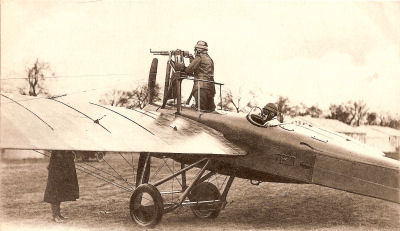 |
 |
Albatross C.IIIA particularly well-preserved image of an Albatross C.III fighter. Powered by a 175 HP Mercedes engine, the aircraft was armed with a single 7.92 Parabellum machine gun in the rear cockpit. Note the line of pockets just under the edge of the observer's cockpit. These held flares. |
Handley Page 0/100 BombersA flight of Handley Page O/100 bombers head off towards Germany on a moonlit night. The HP O/100 was powered by two Rolls-Royce Eagle VII V-12 engines amd could carry a bomb load of two thousand pounds. Number of crew varied according to type of operation and four or five Vickers machine guns were carried for defence. |
 |
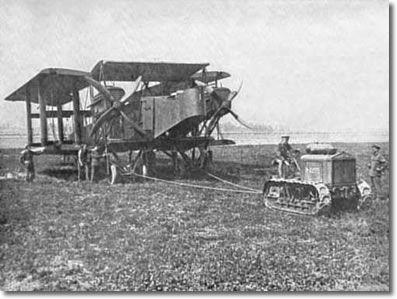 |
A Handley Page O/100 is towed outA Handley Page O/100 bomber is towed out for an operation. The folding wings are a surprising feature for an aircraft this size. |
Bombs are prepared for a raidBombs being laid out for checking and fuzing prior to a raid. This quantity of bombs would be a typical delivery for a squadron of bombers during a night raid. Targets during WWI included communications facilities and munitions factories. The total war that included civilians lay a quarter of a century in the future. |
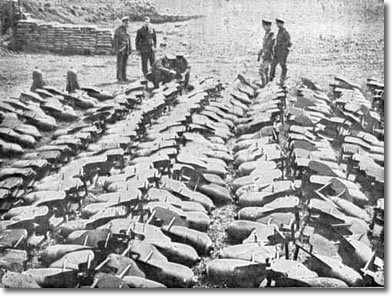 |
 |
A gunner checks his machine gunThe nose gunner of a Handley Page O/100 checks his Lewis Gun. The gun is loaded with a 97 round magazine and is fitted with a bag to catch the ejected cartridges - not an early anti-pollution measure; just a way of keeping the cases from hitting the pilot when firing to starboard. Note also the rear sight ring of the 'ring and bead' sight which helped allow for deflection shooting. |
Anti-aircraft gunners race into actionAnti-aircraft gunners race into action during an alert near Armentieres. |
 |
 |
A Line-up of Sopwith SnipesThe Sopwith Snipe saw service in the last couple of months of WWI. The engine was the Bentley B.R.2. nine-cylinder of 234HP. Armament was two synchronised .303 Vickers machine guns. Max speed was 121 mph. |
Sopwith SnipesSopwith Snipes off on patrol. A 'long-range escort' version of the Snipe just missed the war. |
 |
 |
Zeppelin L33...L33 was one of a number of Zeppelins that raided Britain on the evening of September 23rd 1916. After dropping the bomb load over the East End of London, Captain Alois Bocker flew over Bromley where L33 was hit by an AA shell. Later, after an attack by an RFC night fighter, L33 began to lose height and came to ground near Colchester, where Bocker set light to his papers in the control car to destroy the airship - after thoughtfully warning the occupants of a nearby farm. |
|
The crew then surrendered peacefully to the bicycle-borne Special Constable Edgar Nicholas. The man in the Bowler hat on the ladder is undoubtedly taking critical measurements of the rivets used in the airframe. The sergeant looks grumpy. (Sergeants always look grumpy.) In fact, close examination of the remains of L33 by Lieutenant-Commander AP Cole enabled the secret of the Zeppelins, the complex internal wire bracing, to be understood - and later applied to the building of the highly successful British airships R33 and R34. |
|
A bent Junkers J4The Junkers J4 (army designation J1) was a reconaissance / ground-attack machine which the British thought at one time carried as many as seven machine guns. However, it usually carried just three - a pair firing forwards and a single gun (MG08/15) for the observer. It entered service in 1917. This remarkable aircraft was built of duralumin, corrugated to provide additional structural strength, and the crew and the engine were protected by a 'bathtub' of 5mm steel. The engine was either a 200HP Benz or a 220HP Daimler-Mercedes DIV. |
 |
(Details kindly provided by aviation correspondent Mad Malc.) |
|
|
 |
An Observation BalloonAn observation balloon is prepared for flight. Being a balloon observer was a famously dangerous job. |
A Balloon Observer Prepares to go AloftA balloon observer ready to climb into the basket of his balloon. The thigh length "fug" boots helped the blood circulation on chilly days. Note that the parachute is kept in a container by the side of the basket, and all the observer has to do is to jump over the side to escape. The parachute harness looks fairly crude - if not potentially harmful to post-war marital bliss... |
 |
 |
An Observation Balloon - The Final MomentsAn enemy observation balloon is shot down, leaving an impressive plume of smoke. |
A Balloon Observer EscapesThis balloon observer was lucky and was able to descend by parachute after his balloon was rendered U/S. Aircraft pilots must have envied him his parachute - they were not allowed to carry them. |
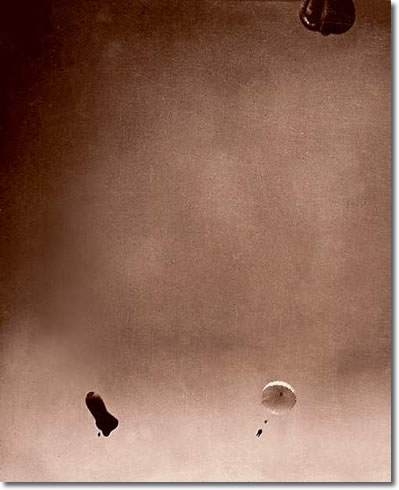 |
 |
The Parachute works, but ...A balloon observer waits for someone to help him down after successfully baling out... |
Mobile Pigeon LoftsLook, this is a WWI aviation page, innit? |
 |
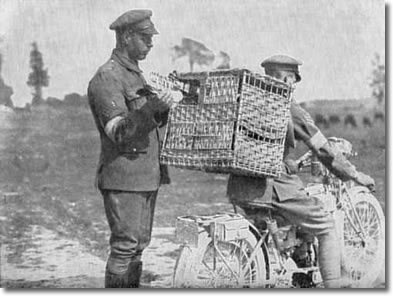 |
Communications on the move - before the cellphone...What the well-equipped biker of WWI should carry. If lost; a way of communicating with HQ. If hungry; a light snack. Transport Correspondent Mad Malc writes: |
An RNAS airshipAn RNAS airship at its mooring. Interestingly, it is parked next to a field where the cavalry moor (ahem, tether) their horses. (The shrouded figures are not a party of visiting nuns - just the horse blankets draped neatly over the posts...) |
 |
 |
Zeppelins in their hangarAlthough the Zeppelin did deal significant death and destruction to mainland Britain the effect on the economy and the war effort was tiny. But the Zeppelin has passed into folklore and, for a couple of decades following WWI, the RAF nickname for bangers and mash was "Zepps in a cloud". |
© Copyright 2007 CairdPublications.com | Site Map | Contact Us |

